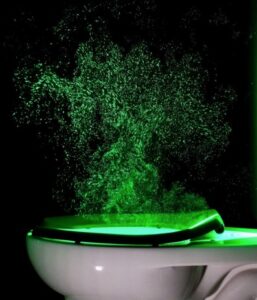Infection control within healthcare settings is a critical concern, necessitating rigorous practices to mitigate the spread of healthcare-associated infections (HAIs). A recent article, “Impacts of lid closure during toilet flushing and of toilet bowl cleaning on viral contamination of surfaces in United States restrooms”, examines the efficacy of various infection control measures, analyzing their impact on reducing HAIs in hospital environments. By evaluating both traditional and innovative methods, the research aims to provide a comprehensive understanding of best practices for infection prevention. The findings are intended to inform policy-making and improve patient safety standards across healthcare institutions.
Aerosols generated during toilet flushing pose a potential route for pathogen transmission
Study Background:
Aerosols generated during toilet flushing pose a potential route for pathogen transmission, making restroom hygiene a crucial concern. The study aimed to assess the impact of closing the toilet lid before flushing and to evaluate the contamination of various surfaces within restroom facilities. We measured the subsequent contamination on toilets and other restroom surfaces by adding a surrogate for the human enteric virus (bacteriophage MS2) to household and public toilet bowls.

Results:
Surface Contamination: After flushing the inoculated toilets, the bottoms of toilet seats showed an average contamination level exceeding 10^7 PFU (phage forming units) per 100 cm². The level of contamination on restroom surfaces was unaffected by whether the toilet lid was up or down during flushing.
Cross-Contamination: Flushing resulted in noticeable cross-contamination, affecting the floor and walls around the toilet.
Effectiveness of Cleaning Products: Introducing a cleaning product into the toilet bowl water reduced bacteriophage levels by more than 99.99%. However, no statistically significant differences were observed in bacteriophage contamination on other bathroom surfaces (including the toilet brush caddy, toilet bowl rim, toilet seat, toilet lid, and floor) before and after using the cleaning product.
Key Highlights:
Aerosol Contamination: Toilet aerosols can contaminate restroom surfaces, including floors, walls, and toilet seats.
Toilet Lid Position: The position of the toilet lid (up or down) prior to flushing does not significantly affect surface cross-contamination.
Disinfection Strategy: The most effective way to reduce cross-contamination in restrooms is by adding a disinfectant to the toilet bowl after flushing waste. This helps minimize the spread of germs during subsequent flushes. In healthcare environments, a detailed cleaning strategy is essential for bathrooms and restrooms to effectively reduce contamination.
Regular Disinfection: Regularly disinfecting all restroom surfaces is essential to mitigate the risk of exposure to contaminated surfaces.
The most effective way to reduce cross-contamination in restrooms is by adding a disinfectant to the toilet bowl after flushing waste.

Interesting Points:
Viral Aerosolization: The aerosolization of viruses from toilets during flushing has gained attention due to concerns about emerging viruses and restrooms’ potential for viral contamination.
Wastewater Analysis: Studies have shown that nearly any human pathogen, including SARS-CoV-2, can be detected in domestic wastewater.
Persistence and Spread: Viral aerosols from toilets can persist for extended periods, travel on air currents, and deposit on surfaces, contributing to the spread of infectious diseases.
Kersia NaDCC
By understanding these dynamics and implementing effective disinfection strategies, we can better protect public health and ensure cleaner restroom environments. Kersia NaDCC effervescent disinfectant tablets are formulated to efficiently and effectively target a broad spectrum of pathogens, ensuring thorough disinfection of toilet bowls, which, as we’ve seen, are highly susceptible to contamination.
Contact our infection prevention experts for information on the benefits of Kersia NaDCC Chemistry: Chris Butler and Matthew Clarke
Link to Article:
https://www.ajicjournal.org/action/showPdf?pii=S0196-6553%2823%2900820-9


